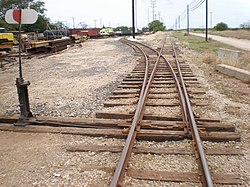Oahu Railway and Land Company

OR&L No. 6, the Oahu Railway's first locomotive, at the Hawaiian Railway Society
|
|
| Dates of operation | 1889–1971 |
|---|---|
| Track gauge | 3 ft (914 mm) |
| Headquarters | Honolulu, Hawaii |
|
Oahu Railway and Land Company
Right-of-Way |
|

A portion of the track is preserved
|
|
| Nearest city | Nanakuli, Hawaii |
|---|---|
| Coordinates | 21°21′14″N 158°1′40″W / 21.35389°N 158.02778°WCoordinates: 21°21′14″N 158°1′40″W / 21.35389°N 158.02778°W |
| Area | 63 acres (25 ha) |
| Built | 1889 |
| Architectural style | 3 ft (914 mm) narrow gauge railroad track |
| NRHP Reference # | 75000621 |
| Added to NRHP | December 1, 1975 |
The Oahu Railway and Land Company, or OR&L, was a 3 ft (914 mm) narrow gauge common carrier railway that served much of the Hawaiian island of Oahu, and was the largest narrow gauge class one common carrier in the U.S, until its dissolution in 1947.
The OR&L was founded by Benjamin Dillingham, a self-made businessman who arrived in Honolulu as a sailor in 1865. After falling from his horse and breaking his leg while riding in the countryside, Dillingham was forced to stay in Hawaii and recuperate. He decided to make the island kingdom his home. Dillingham had a great deal of business acumen and soon became quite wealthy and influential in the early Honolulu community.
Among his development ideas, he conceived in the 1870s of the arid ʻEwa Plain as an excellent location for human settlement. However, there were two problems: a lack of water and, more significantly, a lack of transportation. A trip from Honolulu to the ʻEwa by horse-drawn wagon was an all-day affair. The key was to build a railroad.
Around the time Dillingham was dreaming of his railroad, another businessman, James Campbell successfully dug ʻEwa's first artesian well in 1879, effectively solving the water problem. Campbell, who had purchased 40,000 acres (16,200 ha) of ʻEwa land thought he might start a cattle ranch, but quickly realized that ʻEwa's rich volcanic soil (which overlays a massive ancient coral reef) combined with year-round sunshine and a supply of water was ideal for growing sugarcane. Within a couple of years sugarcane plantations were sprouting up in this southwestern part of Oahu. The need for transportation between the harbor and ʻEwa was becoming essential.
...
Wikipedia

